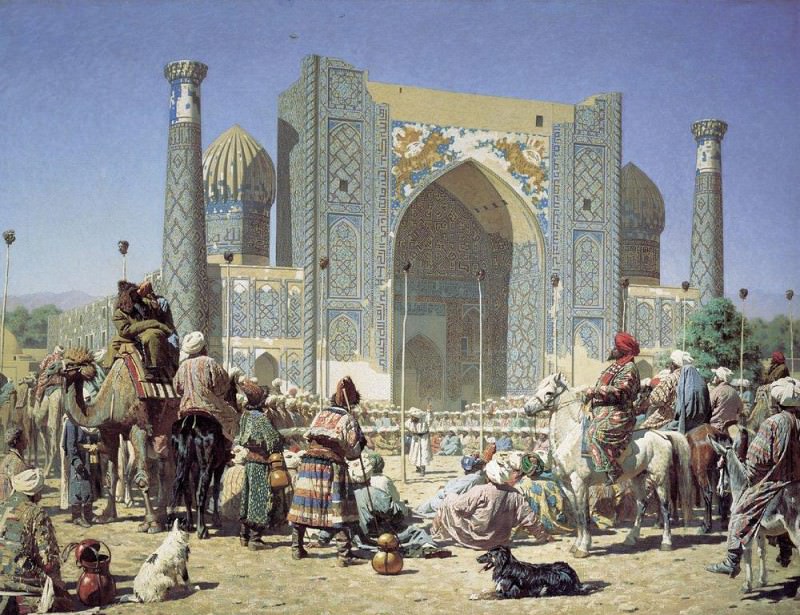Triumph. 1872 Vasily Vereshchagin (1842-1904)
Vasily Vereshchagin – Triumph. 1872
Edit attribution
Download full size: 1000×768 px (0,2 Mb)
Painter: Vasily Vereshchagin
Central Asia. Ancient Samarkand, Registan Square. It is now a national treasure, but on the canvas it is simply a square where people have always flocked to learn something new, or to celebrate an event. On the canvas of the Russian painter Vereshchagin is just a celebration related to the victory over the enemy. It does not matter which one, it is important to show how it all happened. We must begin with the most frightening element of the celebration.
Description of Vasily Vereshchagin’s painting "Triumphant"
Central Asia. Ancient Samarkand, Registan Square. It is now a national treasure, but on the canvas it is simply a square where people have always flocked to learn something new, or to celebrate an event. On the canvas of the Russian painter Vereshchagin is just a celebration related to the victory over the enemy. It does not matter which one, it is important to show how it all happened.
We must begin with the most frightening element of the celebration. A row of poles ran across the square, with the heads of killed enemies sticking out from the top of each pole. As the Indians were scalped, here the head was simply cut off either during the fight (the head was a trophy), or already from the prisoner (if no one had taken it as a slave).
In the very center of the square, a circle of righteous and strong men was formed. If the seats in the circle were occupied, people would ride up to the circle on horses or donkeys and look from this height at the events inside the circle. In the circle itself there would be performances. They could be acrobats, masqueradeurs, fakirs or tightrope walkers. Sometimes in the center there was a witticism, which delighted the ears of listeners with a cheerful talk, or with a simple story about military prowess of the ancestors.
Vereshchagin conveyed exactly the atmosphere that was there at those moments on the square. Despite the heat, there were always a lot of people. But it is interesting that the artist was able to observe the main condition of any Muslim. The faith forbids painting people’s faces. And not to offend anyone, the painter didn’t begin to put anyone’s face on the canvas, he just turned everybody’s back to the audience, as if unobtrusively inviting them to have a look into the circle.
Of course, the artist had sketches and paintings where faces were drawn, but on this particular canvas, the Koranic rule was irreproachable. Maybe it was meant that way, or maybe the painter really knew about the condition.
Кому понравилось
Пожалуйста, подождите
На эту операцию может потребоваться несколько секунд.
Информация появится в новом окне,
если открытие новых окон не запрещено в настройках вашего браузера.
You need to login
Для работы с коллекциями – пожалуйста, войдите в аккаунт (open in new window).




















COMMENTS: 2 Ответы
camel is amazin!
Camel is supercamel
You cannot comment Why?
The painting, titled Triumph, depicts a vibrant scene in front of a grand, intricately decorated building with tall, blue-tiled minarets. The architecture itself suggests a rich cultural heritage, possibly Central Asian or Middle Eastern, with its mosaic patterns and imposing domes.
In the foreground, a bustling marketplace or gathering is underway. People are dressed in colorful, traditional attire, some on horseback and others with camels, indicating travel and trade. The figures are varied in dress and activity, adding to the sense of a lively and diverse community. Dogs are also present within the crowd, suggesting domestic life integrated with public spaces.
The painting evokes a sense of triumph through its title and the grandeur of the setting. This triumph could be interpreted in several ways:
The bright sunlight and clear sky contribute to an overall optimistic and celebratory mood, reinforcing the theme of triumph. The rich detail in the clothing, the animals, and the textures of the buildings invite the viewer to immerse themselves in this historical and cultural moment.